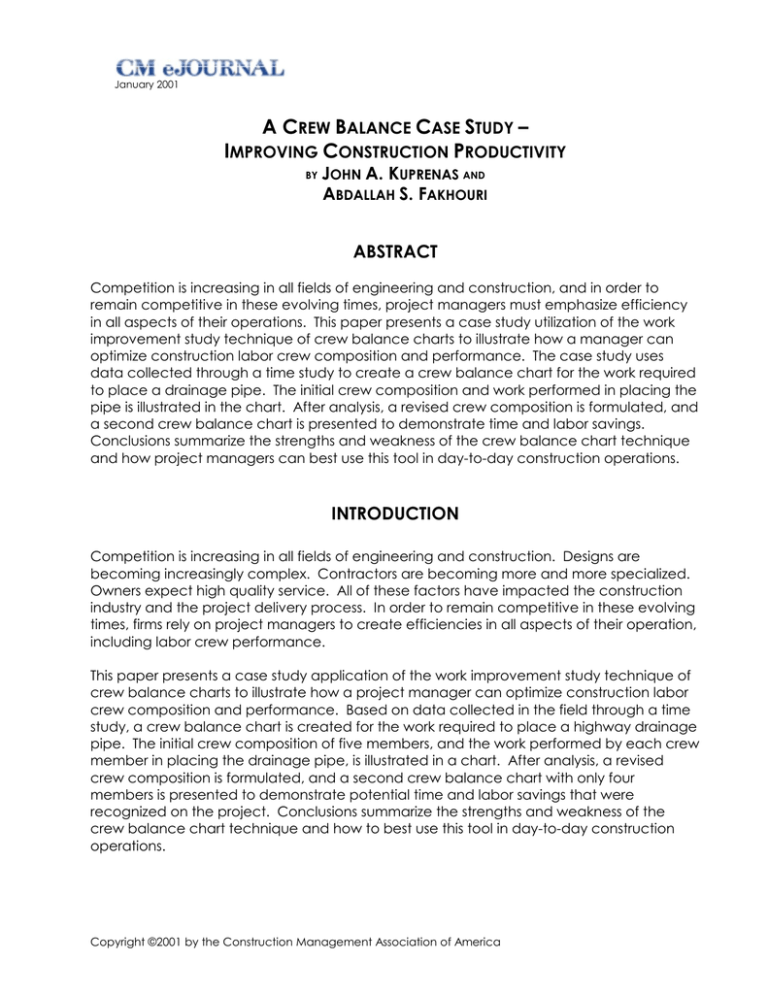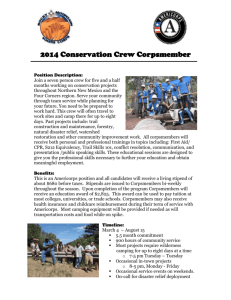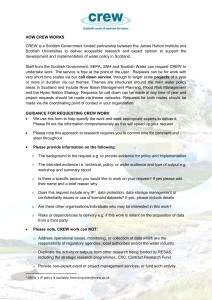A C B C
advertisement

January 2001 A CREW BALANCE CASE STUDY – IMPROVING CONSTRUCTION PRODUCTIVITY BY JOHN A. KUPRENAS AND ABDALLAH S. FAKHOURI ABSTRACT Competition is increasing in all fields of engineering and construction, and in order to remain competitive in these evolving times, project managers must emphasize efficiency in all aspects of their operations. This paper presents a case study utilization of the work improvement study technique of crew balance charts to illustrate how a manager can optimize construction labor crew composition and performance. The case study uses data collected through a time study to create a crew balance chart for the work required to place a drainage pipe. The initial crew composition and work performed in placing the pipe is illustrated in the chart. After analysis, a revised crew composition is formulated, and a second crew balance chart is presented to demonstrate time and labor savings. Conclusions summarize the strengths and weakness of the crew balance chart technique and how project managers can best use this tool in day-to-day construction operations. INTRODUCTION Competition is increasing in all fields of engineering and construction. Designs are becoming increasingly complex. Contractors are becoming more and more specialized. Owners expect high quality service. All of these factors have impacted the construction industry and the project delivery process. In order to remain competitive in these evolving times, firms rely on project managers to create efficiencies in all aspects of their operation, including labor crew performance. This paper presents a case study application of the work improvement study technique of crew balance charts to illustrate how a project manager can optimize construction labor crew composition and performance. Based on data collected in the field through a time study, a crew balance chart is created for the work required to place a highway drainage pipe. The initial crew composition of five members, and the work performed by each crew member in placing the drainage pipe, is illustrated in a chart. After analysis, a revised crew composition is formulated, and a second crew balance chart with only four members is presented to demonstrate potential time and labor savings that were recognized on the project. Conclusions summarize the strengths and weakness of the crew balance chart technique and how to best use this tool in day-to-day construction operations. Copyright ©2001 by the Construction Management Association of America A Crew Balance Case Study Improving Construction Productivity January 2001 WORK IMPROVEMENT STUDIES One fundamental element of quality control is optimization of ongoing work processes (PMBOK 1996). The objective of labor crew work improvement studies is to analyze the ongoing work of construction crews and determine whether the methods and techniques being used by the crew are optimal and, if not, what methods could be used by the crews. Two elements are needed in any work improvement study – a data collection technique and a data analysis technique (Ogelsby et al 1989). Data collection is often a difficult task because it is nearly impossible to observe and record all of the details and the planning of ongoing construction work. Hence, the objective of any data collection technique is to approximate as accurately as possible what is taking place in the field. Several techniques have been well documented for construction data collection, namely: !"Questionnaires and interviews (Chang and Borcherding 1985) !"Delay surveys (Heinze 1996, Tucker et al 1982) !"Activity sampling (Thomas and Daily 1983) !"Recording of work face practices Each technique has been used extensively in the past. Some techniques may be more appropriate for certain types of work because of work characteristics (i.e. cyclical, complex), methods to perform the work (equipment intensive, large/small crews), or the nature of the project (large site, degree of supervision). Once data has been collected, analysis is needed. Analysis serves as a method to present the data and communicate results or conclusions. Data analysis of construction operations has been well researched – the techniques used in construction include: !"Crew balance charts !"Process flow charts !"Simulation !"Belief networks !"Algorithms !"Attributes and factor models Crew balance charts present one simple, fast, easy to understand alternative to these techniques that any practicing project manager can use to improve construction jobsite labor performance. Copyright ©2001 by the Construction Management Association of America 2 A Crew Balance Case Study Improving Construction Productivity January 2001 CREW BALANCE CHARTS The crew balance chart concept was developed by industrial engineers and was known as a man-machine chart. The man-machine chart showed the production capabilities of various worker-machine combinations. Given the uncertain nature of an ongoing construction project, the construction industry also needs a tool to study alternate activity sequences and activity durations (PMBOK 1996). One tool available to the construction industry is crew balance charts. Crew balance charts are a graphical technique used to show the sequential activities (with time durations) for the actions of individual crew members working on a cyclical construction task. A crew balance chart consists of a series of vertical bars scaled against a time or progress measure. The vertical bars on a crew balance chart are shown across the x-axis with each bar representing an individual crew member. Hence, the more bars shown, the more crew members present in working on the task. In addition, the individual crew member vertical bars are subdivided through shading and patterns to show the specific subtasks (with times) that the crew member is performing. The y-axis is shown as time – either as recorded (minutes, seconds) or as a percentage of the total cycle for the task (O’Brien and Zilly, 1991). Since each element of time for each crew member is plotted to the same time scale, the interrelationship of the various crew members and sub-tasks can be studied through a comparison along any line parallel to the x-axis on the chart. Construction field staff can rearrange task assignments among various members of the crew in order to reduce or eliminate non-productive time and thereby increase efficiency (Alfeld 1988). Crew balance charts must be used with caution when assessing productivity, since simply working (being busy) does not necessarily mean that the best method to complete the task is being used. In addition, the bars do not necessarily reflect the work pace. A oneminute sub-task for a crew member may in fact truly only require 30 seconds (Ogelsby et al 1989). Case Study The crew balance charts of this study are those created for a general contractor performing work on a recent highway construction project in the Western United States. The project was a design-build toll road segment of the Eastern Transportation Corridor located in the heart of Orange County, in the State of California. The 26 mile long Toll Road connects the Riverside Freeway in Anaheim Hills to the Santa Ana Freeway in Coto DeCaza. Different crews in each segment of the project are responsible for different tasks, such as bridge concrete placement, minor structures concrete placement, and pipe installations. The project has many drainage structures that collect runoff from the road proper and either side of the road. Copyright ©2001 by the Construction Management Association of America 3 January 2001 A Crew Balance Case Study Improving Construction Productivity A crew balance chart study was conducted on a drainage structure pipe installation crew in order to document current crew usage and identify potential management actions and changes to save time or resource requirements for the task. The crew balance case study process consisted of five steps: 1. Identification of a cyclical activity to be studied. 2. Observation of crew composition and tasks. Recording of time spent on each task for several activity cycles. 3. Graphical depiction of the data collected through creation of a crew balance chart. 4. Analysis of crew balance chart to identify potential areas for improvement. Target areas to check include idle time by crew members, redundant work by crew members, need for specific tasks, sequencing of activity tasks, interaction with equipment and/or materials. 5. Use of results of chart analysis to revise task process and measurement of any potential task improvement (safety, cost, schedule, quality, or otherwise). The particular pipe installation crew studied was responsible for placing a 3,700 foot long, 42 inch diameter, concrete pipe placed in fifty-foot sections, running parallel to the northbound lanes of the road. Initial Condition Data was collected through time studies conducted by staff working on the site. A field manager observed detailed crew activities over the initial section of the drainage structure. The manager made time measurements over several cycles for the pipe installation in order to validate the accuracy of the times and actions of the crew members and account for the variation among cycles. The initial crew composition and tasks were done by the general contractor based on their standard practices for the type of work under study. The time study immediately found that the pipe laying crew composition was not consistent; the size usually depends on the size of the pipe and the amount of work to be done. However, in most occasions and in this study, the contractor’s crew consisted of five crew members, four of whom were laborers (designated Laborer #1 to Laborer #4 in the charts) and one who was a backhoe operator (designated Operator in the charts). A pipefitter was not needed for the work because the pipe was concrete pipe with push joints. Copyright ©2001 by the Construction Management Association of America 4 A Crew Balance Case Study Improving Construction Productivity January 2001 The crew balance chart for the work is shown in Figure 1. Laborer #1 and Laborer #2 worked inside the trench – shoveling dirt to grade for the pipe after excavation, setting the pipe in the trench, joining the pipe sections, sandbagging head-wall where the pipe junctions with other pipes, and shoveling slurry around the junction structures. Laborer #3 also worked inside the trench with the primary responsibilities of checking grade for the pipe as the backhoe excavated, assisting in setting pipe in trench, and directing operations -- especially slurry backfill. Laborer #4, on the other hand, worked outside the trench. Laborer #4’s main jobs were assisting in grade checking, if Laborer #3 could not see outside the trench, and hooking pipe sections to the backhoe to be lifted and placed into the trench. The Operator’s job was straightforward -- digging the trench, lifting the pipe off the ground, and lowering it into the trench. Excavated material was used to backfill the trench. Figure 1 250 standby/reposition 200 direct slurry sandbag headwalls set pipe join pipes lift pipe hook pipe Cumulative Time (minutes) shovel slurry 150 100 wait 60 30 60 60 120 120 30 30 15 15 15 15 15 15 15 15 15 15 15 15 15 15 15 15 15 15 15 15 15 60 60 60 50 grade 45 60 check grade cut 15 0 Laborer #1 Laborer #2 Laborer #3 Laborer #4 Operator Crew Member As shown in Figure 1, Laborers #1 and #2 tended to perform most of the work inside the trench. They finish graded the trench as deemed necessary by Laborer #3, who acted as a grade checker for the first 60 minutes of work. Laborers #1 and #2 also set the pipe in the trench, joined the pipes, stacked sandbags around the headwall of the structure, and shoveled slurry. As shown in Figure 1, Laborers #1 and #2 only had an opportunity to rest or wait for 15 minutes (which is mandatory by union agreement). Copyright ©2001 by the Construction Management Association of America 5 January 2001 A Crew Balance Case Study Improving Construction Productivity Laborer #3 was the acting foreman; hence, he was allowed to direct the crew’s activities. Laborer #3 performed various tasks; for the first 60 minutes, after the operator finished excavating, Laborer #3 calculated (shot) the grade inside the trench to verify bottom grade for pipe. Laborer #3 was allowed to acquire help from Laborer #4 if it was difficult to shoot grade to a nearby elevation stake. Laborer #3 assisted in setting the pipe inside the trench, stacking sandbags around the headwall of the structure, and guiding the concrete trucks when backfilling over the pipe with slurry. However, as shown in Figure 1, Laborer #3 had more waiting time, simply because Laborers #1 and #2 were also in the trench doing the rest of the work. Laborer #3 may seem to have had an easier job to do; however he or she was responsible for all the activities when the field management was not present. In the Figure 1, Laborer #4 assisted in checking grade for the first 15 minutes since Laborer #3 often had difficulties checking grade while inside the trench. After Laborer #4 assisted in checking grade for 15 minutes, he waited for 45 minutes outside the trench until all grading was complete in order to hook the pipe section on the backhoe. When the operator was in the process of lifting and setting the pipe section inside the trench, Laborer #4 had to wait until the backhoe was ready for the next section. Finally, as soon as the last section of pipe was hooked on the backhoe, Laborer #4’s work was done. It is immediately clear from the initial crew balance chart that Laborer #4 was not being used in the most effective manner, given Laborer #4’s large amount of idle time. The operator’s work was digging the trench for the first 60 minutes, waiting for 15 minutes until Laborer #4 finished and hooking the pipe section to the backhoe, then lifting and setting the pipe section inside the trench. The lifting and waiting pattern continued until the last piece of pipe was set inside the trench. As a result, all the activities in the initial chart required four Laborers and an operator to install a 50’ section of the pipe in approximately 235 minutes, almost four hours. Copyright ©2001 by the Construction Management Association of America 6 A Crew Balance Case Study Improving Construction Productivity January 2001 CREW PERFORMANCE ADJUSTMENTS The most important step in the process of the study is analysis of the crew balance chart to identify potential areas for improvement. The client agency project engineer and the contractor’s foreman and superintendent checked the areas identified in step 4 above (idle time by crew members, redundant work by crew members, the need for specific 250 Figure 2 standby/reposition direc t slurry sandbag headwalls s et p ipe join pipes lift pipe hook pipe wait Cumulative Time (minutes) s ho ve l s lurry 200 60 60 60 30 30 30 15 15 15 15 15 15 15 15 15 15 15 15 15 15 15 15 15 15 60 60 60 La borer #2 La borer #3 O p era tor 120 150 100 50 45 grade check grade 15 0 c ut La borer #1 C rew M em b er tasks, the sequencing of activity tasks, and interaction with equipment). Based on this analysis, a revised task process was formulated as shown in Figure 2. In Figure 2, Laborer #4 was completely eliminated, with the work formerly assigned to Laborer #4 turned over to the Operator to perform (instead of waiting). The Operator’s revised responsibility was to check grade for the first 60 minutes and then hook and set the pipe into the trench until all pieces were placed. By having the backhoe operator perform the work of Laborer #4 (other than checking grade), it was easier to have Laborer #4 removed from the crew. Since Laborer #4 was no longer a member of this crew, Laborer #1 had to go outside the trench and assist in checking grade for the first 15 minutes. The crew balance chart analysis showed that Laborer #1 was not necessary to assist in shoveling the slurry (after minute 160) since the slurry being placed over the pipe required only one laborer to do the work. Figure 2 shows that Laborers #2 and #3’s work activities did not change. The proposed method graphically shows that Laborer #4 was eliminated, and all other changes were organized to show the interrelationships among the remaining crew members and the operator. Based on the work improvement analysis above, the time required to complete the drainage pipe placement activity was unchanged. The cost of the activity, however, was Copyright ©2001 by the Construction Management Association of America 7 A Crew Balance Case Study Improving Construction Productivity January 2001 reduced by 20% (assuming equal wages for all crew members), and Laborer #1 had additional time available for other tasks (apart from setting the pipe) during the latter part of the cycle. The contractor did not, however, consistently use these suggested crew changes on the project tasks. Since production goals were being met by the foreman, little incentive was present to change the process (given the risk of uncertainty). Analysis of the Tool Regardless of any studies, the presence of a foreman or a superintendent is essential for labor to be most productive. When the foreman or superintendent is present, a decision regarding crew composition can be made immediately as the needs of the project dictate. In many cases, the foremen will drive around the site checking on their crews and make their decisions regarding moving people and managing their work based on visual observation of the operations. The entire crew balance chart process was not difficult. The observation of contractor crews was already a work requirement for the field engineer, and no more than one afternoon of work was required by the field engineer to create the diagrams. Given this small investment, crew balance charts present a valuable tool for field management to use to improve crew efficiency. They are beneficial at several levels: !"They create an awareness of crew activities. !"They establish a performance mindset that makes cost and schedule control a daily occurrence. !"They are a visual tool that allows easy evaluation of a task and work conditions. !"When used to create revised crew member compositions and tasks, they can be used to reduce activity durations or reduce crew member non-productive time. Future research should focus on automating the analysis process after creation of the initial crew balance chart. The automation issue is well suited to a mathematical optimization methodology. Other research in optimization of similar processes has proven successful (Li 1996, Son and Skibniewski 1999). CONCLUSIONS This work introduced construction work performance improvement studies and the data collection and analysis techniques used in these studies. Crew balance charts are an effective graphical tool to illustrate the current status of a crew and potential changes that can be made as part of a work improvement study. A case study use of crew balance charts to optimize construction labor crew composition and performance was presented. Based on data collected in the field through a time study, a crew balance chart was created for the work required to place a highway drainage pipe. The initial crew composition of five members and the work performed by each crew member in placing the drainage pipe was illustrated. After analysis, a revised crew composition was Copyright ©2001 by the Construction Management Association of America 8 A Crew Balance Case Study Improving Construction Productivity January 2001 formulated, and a second crew balance chart with only four members was developed to show 20% savings in labor costs while maintaining the original activity duration. Case study conclusions highlight the strengths of the approach, as well as opportunities for additional research. There are many items that one must consider when managing a project; however, analysis tools such as crew balance charts have the potential of significant savings of resources and time when used on a project. Work performance improvements that may seem obvious when shown in a crew balance chart format may go entirely overlooked in the busy nature of a contemporary complex construction project. By taking the time to develop these charts on cyclical project activities, field supervisors and managers may recognize significant benefits. REFERENCES Alfeld, Louis E. (1988). Construction Productivity, McGraw Hill, Inc., New York, New York, p. 108-111. Chang, Luh-Maan and Borcherding, John D. (1985). “Evaluation of craftsman questionnaire”, Journal of Construction Engineering and Management, ASCE, 111 (4), p. 426-437. PMBOK – A Guide to the Project Management Body of Knowledge, (1996) Project Management Institute, William R. Duncan, ed., Upper Darby, Pennsylvania, p. 71-72. Heinze, Kurt (1996). Cost Management of Capital Projects, Marcel Dekker, Inc., New York, New York, p. 562-564. Li, Shirong (1996). “New approach for optimization of overall construction schedule”, Journal of Construction Engineering and Management, ASCE, 122 (1), p. 7-13. O'Brien James J. and Zilly, Robert G. (1991). Contractor’s Management Handbook, McGraw Hill, Inc., New York, New York, p. 22.17-22.25 Oglesby, Clarkson H.; Parker, Henry W. and Howell, Gregory A. (1989). Productivity Improvement in Construction, McGraw Hill, New York, New York Son, Jaeho and Skibniewski, Miroslaw J. (1999). “Multiheuristic approach for resource leveling problem in construction engineering: hybrid approach”, Journal of Construction Engineering and Management, ASCE, 125 (1), p. 23-31. Thomas, H. Randolph and Daily, Jeffrey (1983). “Crew performance measurement via activity sampling”, Journal of Construction Engineering and Management, ASCE, 109 (3), p. 309-320. Copyright ©2001 by the Construction Management Association of America 9 A Crew Balance Case Study Improving Construction Productivity January 2001 Tucker, Richard J.; Rogge, David F.; Hayes, William R., and Hendrickson, Frank P. (1982). “Implementation of Foreman-delay Surveys”, Journal of the Construction Division, ASCE, Vol. 108, CO4, p. 577-591. KEY WORDS: Project Planning, Cost Control, Productivity, Time Studies, Crew Balance, Supervision About the Authors John Kuprenas is a Senior Project Manager with Vanir Construction Management and Abdallah Fakhouri is a Transportation Engineer with the California Depart of Transportation, District 07. Copyright ©2001 by the Construction Management Association of America 10




